The much anticipated and already announced Sandy Bridge Xeons were supposed to follow desktop and notebook counterparts in short order, however it seems like everything Sandy Bridge is on hold while Intel rectifies Cougar Point. However, the new Sandy Bridge Xeons are here! Today attention is on the Xeon E3-1220 which is a 3.1ghz quad core without Hyper-Threading or on-board graphics. It does have an 80w TDP, AES-NI, ECC support, VT-x and VT-d support and a host of other desirable features for the server market.
Just to give readers perspective on the lineup, here is the February 2011 (pushed to April 2011 due to the Cougar Point bug) Intel Xeon E3-1200 series launch line-up:

A quick note, C200 series motherboards seem to be under NDA/ embargo as of February 2011, so that is probably the reason for the lack of reviews. Finding LGA 1155 motherboards is tough at the moment as the world awaits the B3 stepping of Cougar Point to finally arrive. Luckily, this turned out to be less of an issue than I had thought it would be. Another note, things like CPU-Z do not properly recognize the new chips at this point so consider this a CPU performance preview.
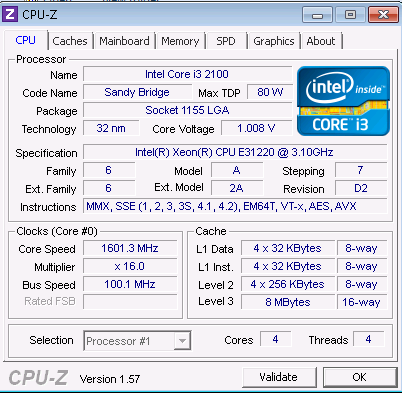
Ed. It does appear that Intel has pulled the E3-1200 family from channels where quite a few people have received the chips lately. After speaking with Intel, it seems as though the early release of the few chips was due to a distributor mix up resulting in a premature release. The Xeon E3 series has not been released, which is why as of March 14 there is no information on Intel’s site, yet but I expect more information to be forthcoming in the near future. Being clear, the Xeon E3 chips have not launched yet and that is the reason for their unavailability.
Test Configuration
Finally being able to post power consumption numbers on a proper platform is important because IPMI 2.0 and KVM-over-IP are becoming must-have features on new server motherboards. The Supermicro X8SI6-F was one of the most popular motherboards reviewed on this site for the Lynnfield platform as it incorporated a LSI SAS2008 SAS 2.0/ SATA III 6.0gbps 8-port controller onboard. I therefore used the most similar motherboard I had at launch, the Tyan S5512WGM2NR to perform the testing.

- CPU: Intel Xeon E3-1220
- Motherboard: Tyan S5512WGM2NR
- Memory: 8GB 1333MHz CL9 DDR3 (4x2GB)
- OS Drive: OCZ Agility 2 120GB
- Additional NICs: Intel Gigabit CT PCIe x1 network adapter
- Enclosure: Norco RPC-4224
- Power Supply: Seasonic X650 (650w Gold level power supply) PicoPSU 150XT with 150w power supply
Update 5 April 2011: Today Intel announced the Xeon E3-1220 CPU, and I am able to publish power consumption numbers using a proper C204 board, a Tyan S5512WGM2NR. I have updated the power consumption numbers herein. I had originally posted the review using a ASUS P8H67-M EVO so the new Xeon E3 series CPUs do work in at least some consumer motherboards which is much better than the LGA 775 and 771 days.
The Tests
Since there is scant to no performance information on the C200, I decided to add a few more tests than I normally do for storage focused CPU reviews. This included Cinebench R11.5 which is a great multi-threaded benchmark, 7-Zip compression benchmarks, and Truecrypt encryption benchmarks. For comparison’s sake, I also ran the Lynnfield Xeon X3440 and X3460 through the same battery of tests. I am skipping gaming benchmarks because that is really unnecessary on a server CPU. My personal i7-2600K runs stable at 5.0ghz and was only slightly more expensive, so it is hard to justify using a Xeon for gaming at this point. That is a big departure from the Xeon W35xx W36xx and X34xx series CPUs that were similar to their Core i7 counterparts in terms of FSB overclocking.
Windows Experience Index
Personally, I think that Microsoft’s built-in relative performance indicator, the Windows Experience Index (WEI) does not do enough to stress and stratify CPUs, especially at the upper-end. With that being said, a lot of readers ask for WEI scores so I have learned to oblige.

7.4 CPU score is in the same area as the previous generation Xeon X3440 that coincidentally occupies the same price point that the Xeon E3-1220 is targeting. One may question the 3.3 showing as the WEI total, that is courtesy of the GeForce 7200 GS GPU. For those regular readers, this is well below what the Intel Graphics HD 3000 scores.
Cinebench R11.5
I have been using Cinebench benchmarks for years but have held off using them on ServeTheHome.com because the primary focus of the site until the past few months has been predominantly storage servers. With the expansion of the site’s scope, Cinebench has been added to the test suite because it does represent a valuable benchmark of multi-threaded performance. I have had quite a few readers contact me about this type of performance for things like servers that are Adobe CS5 compute nodes and similar applications. Cinebench R11.5 is something that anyone can run on their Windows machines to get a relative idea of performance.
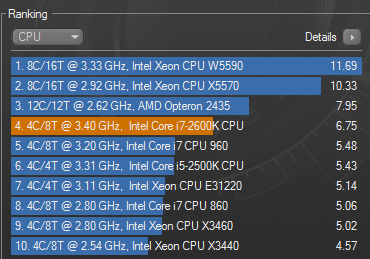
Here the Intel Xeon E3-1220 really shows what it is made of. My hypothesis was that the X3460 would be significantly faster than the E3-1220 but I was clearly incorrect. If one already has a Lynnfield family CPU with Hyper Threading, at least the non-Hyper Threaded CPUs like the Xeon E3-1220 and Core i5-2500K are not a significant upgrade. The Core i7-2600K does show a sizable lead among the 4-core CPUs.
7-Zip Compression Benchmark
7-Zip is an immensely popular compression application with an easy to use benchmark.
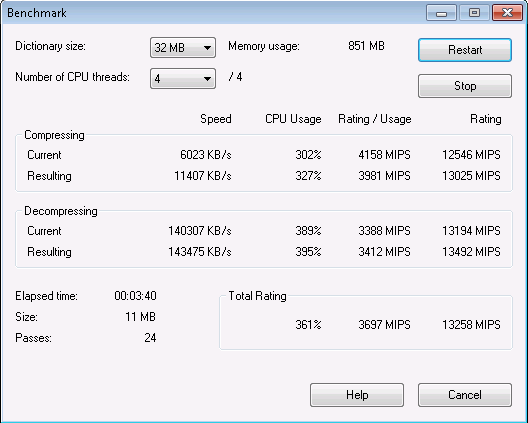
In 7-Zip, the E3-1220 does fall behind the previous generation Hyper-Threaded X3440 and X3460 parts and the Core i5-2500K and Core i7-2600K. As a non-Hyper-Threaded Sandy Bridge core, it performs just below the Core i5-2500K. One can surmise that the 200MHz clock speed advantage for the Core i5-2500K is more beneficial beneficial over what the Xeon E3-1220 enjoys.
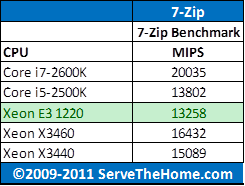
I was a bit surprised to see 7-Zip take advantage of Hyper-Threading this well because the clock speed and architecture of the Xeon E3-1220 should favor it over the previous generation Lynnfield CPUs.
TrueCrypt Encryption Benchmarks
With Intel’s focus on its AES-NI features TrueCrypt can look a bit skewed. Unlike some dubious drivers over the years that were optimized for benchmarks over real world application, Intel’s AES-NI feature does encompass the addition of specialized hardware. This specialized hardware has many practical uses and is becoming more supported. For example, users of Solaris 11 can utilize the AES-NI features to see much higher throughput on encrypted volumes. Without further waiting, here is the Intel Xeon E3-1220 TrueCrypt benchmark run:

As one can see, the AES benchmark is through the roof. 2.4GB/s is enough to feed the outer edges of sixteen modern 3.5″ SATA/ Nearline SAS disks. Here is the Xeon X3440 for comparison.
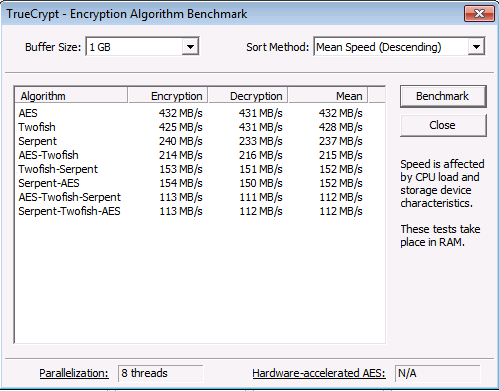
One can see that the new E3-1220’s lack of Hyper-Threading does have a significant impact on the other metrics, and in some cases the X3440 is able to come out ahead. Perhaps one of the most important things about the above is that the Xeon E3-1220 is able to see 130MB/s in each area, meaning single GigE transfers will not be slowed by the E3-1220’s processing capability.
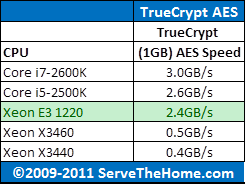
As for the AES performance, the above speaks volumes. Sandy Bridge benefits from higher clock speeds and hardware instructions, and Hyper-Threading is less of an advantage.
Handbrake 0.9.5 x264 Encoding Benchmarks
As was noted in the Sandy Bridge Reviews, I am moving from DVD quality to Blu-Ray quality encoding with Handbrake this year. During the transition period, I will still have both sets of numbers, however CPUs reviewed previously may not get re-tested for the newer HD test.
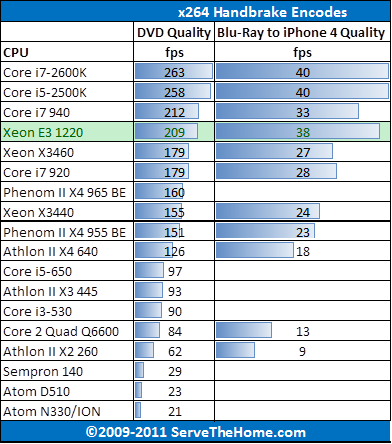
As one can see, the Xeon E3-1220 is a powerhouse of media encoding like its Sandy Bridge desktop brethren putting significant distance between it and Lynnfield and Bloomfield CPUs. One really interesting note here is that one can see just how far Intel’s architecture has progressed over the past few years. The Core 2 Quad Q6600 also has 8MB of on-die cache (albeit L2) four cores, no Hyper-Threading, and a stock clock of 2.4GHz. The 700MHz clock speed advantage amounts to just shy of a 30% improvement in clock speed, yet in four years since the Q1 2007 Q6600 launch, the lower-end quad cores now encode video about 300% faster, and consume less power.
Power Consumption
- Update 5 April 2010, I previously published power consumption figures of the Xeon E3-1200 series CPUs using an Intel H67 based motherboard and discrete GPU because the Bromolow platform had not launched. Today I am able to update the figures using a Tyan S5512WGM2NR C204 based motherboard.
-
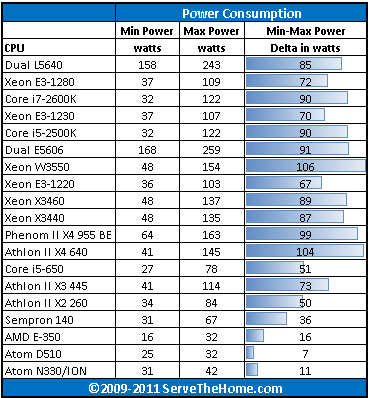
Intel Xeon E3-1220 Power Consumption One can note that, like the E3-1230 and E3-1280, the test configuration idled at under 40w at the Windows 7 desktop with a PicoPSU 150XT two 1.5v DDR3 DIMMs, and an OCZ Agility 2 120GB. I went back through previous reviews though and took the min and max numbers I used to generate deltas. Overall, the new chips are pretty awesome in terms of performance/ watt.
Best to think of the above as a relative guide given the platform differences (the N330 uses DDR2 for example) with the above. There are some variations between chips, so actual values may vary a bit even with the same model number due to different default voltages. Although the numbers were in-line with expectations, I will note that I am starting to believe that the E3-1230 sample I have is perhaps a higher-quality bin chip which lead it to be closer to the E3-1220 than the E3-1280. However, with such a small differential, the Xeon E3-1220 is really a solid CPU. Power efficiency at load and the capacity to complete tasks faster at load, along with solid power-gating minimizing idle power consumption, Intel looks like it will have a winner with these new Xeons in the UP market, at least until AMD’s Bulldozer arrives en masse.
Conclusion
For owners of Lynnfield servers, there is very little reason to upgrade unless one is either doing AES encryption on a platform that supports Intel’s AES-NI features or extra CPU speed is holding the server back. Power consumption wise, Sandy Bridge does seem to be better but even at 100% CPU utilization the costs of a platform change are going to be too high to justify power savings in most cases. On the other hand, for those building new servers, Sandy Bridge will be the way to go for new systems. With that being said, Lynnfield is still quite competitive, especially if prices fall or if one is buying second-hand. As of February 2011, if one wants ECC support, IPMI 2.0 and other server must-have’s, Lynnfield platforms is the only viable alternative. Overall, the performance is really great with the new Sandy Bridge Xeons like the E3-1220 and the UP market is in for a shakeup. One should not forget that these CPUs are in the $230-240 range so they are, from a price perspective, competitive with the Intel Xeon X3440 not the higher-end Lynnfield parts.
Of course, one is probably thinking, “why not test one with Hyper-Threading?” That is a great point, I just wanted to get this out as soon as I could. In the next few days expect a Hyper-Threaded variant to be reviewed on ServeTheHome.




Fantastic (p)review. In the market for a home server and may get this processor. Can you please clarify on the following:
“As of February 2011, if one wants ECC support, IPMI 2.0 and other server must-have’s, Lynnfield platforms is the only viable alternative.”
Is this due to availability of the boards while the problems get rectified?
Cheers!
How ironic. I visited this site just last night and had questions on the performance gain of hyper-threading, so I did some Googling and ended up back here! :)
Thanks for the update Patrick, I look forward to the hyper-threaded chip review to see the performance gain from that feature and if it is worth the extra price premium.
edk: The C200 series boards are not available yet and today is the last day in February. The desktop Cougar Point boards do not support ECC and do not have IPMI 2.0 so there is no way to get these features with a Xeon E3-1200 series CPU. Once the boards come out this will change.
unclerunkle: Glad to help. Will have more over the next few days, however I am a bit throughput limited at this point as I have tons of hardware to review.
Hey Patrick,
Great review mate.
Sorry its a bit off topic but how do you rate the supermicro sc731 and have you seen much of an effciency difference between the supermicro 300w 80+ psu and the pico? Thanks
nice work patrick.
[…] of the part. Recently ServeTheHome has looked at virtually all of the no-GPU Xeon E3 including the Xeon E3-1220, Xeon E3-1230, Xeon E3-1240 and Xeon E3-1280. Like the other Xeon E3-1200 CPUs, the E3-1270 has an […]
[…] publishing the first Sandy Bridge Xeon review of the E3-1220 a big question remained, what would the performance of hyper-threaded versions of the new Intel […]